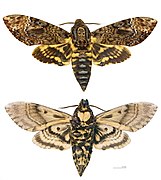Acherontia
| Acherontia | ||||||||||
|---|---|---|---|---|---|---|---|---|---|---|

Skull hawk ( Acherontia atropos ) |
||||||||||
| Systematics | ||||||||||
|
||||||||||
| Scientific name | ||||||||||
| Acherontia | ||||||||||
| Laspeyres , 1809 |
Acherontia is a genus within the butterfly family of swarmers (Sphingidae). The species of the genus occur in the Old World .
features
The moths are large and strongly built. The forewings are large and dark in color, the hind wings are yellow and have a black submarginal band. There is a skull-shaped drawing on the back of the thorax . The proboscis is stocky, shorter than the thorax and hairy. The opening is on the top in front of the tip. The labial palps are clearly separated. The antennae are stocky, evenly thick and curved into a hook at the end. The abdomen bears a yellow rib-like drawing. The tibiae of the hind legs have two pairs of spurs. The tarsi of the middle and rear pairs of legs are strongly compressed.
The eggs are pale green or bluish and relatively small.
The caterpillars are variable in color. Their yellow or light brown anal horn is characteristically covered with wart-like pustules, "S" -shaped and curved downwards. In the last stage of the caterpillar, clear, oblique, two-tone stripes run along the sides of the body and the back is spotted. The caterpillars can make crackling noises with their mandibles .
The pupa is smooth and shiny, the proboscis is fused with the body. The cremaster is wide and has two short end points.
Way of life
The adults can make a whistling, shrill sound when disturbed. The caterpillars feed on trees, shrubs and herbaceous plants, mainly from the families of the nightshade family (Solanaceae), trumpet tree family (Bignoniaceae), verbena family (Verbenaceae) and olive family (Oleaceae).
Taxonomy and systematics
In Europe the genus Acherontia is only represented by the skull hawk, three species of the genus are known worldwide. The genus Acherontia is placed together with four other genera in the tribe Acherontiini, the monophyly of which is well founded. The relationships between the genera within the tribe have not been fully explored, but it seems certain that Acherontia is most closely related to the genus Coelonia , which therefore forms the sister group. The three species of Acherontia are well separated from Coelonia . Based on morphological studies of adults, caterpillars, pupae and host plants, it was possible to show that Acherontia atropos is closely related to Acherontia styx , the sister taxon of the two species is Acherontia lachesis .
The genus name Acherontia is derived from Acheron , one of the five rivers of the underworld from Greek mythology. The specific epithet of all three species is also related to the Greek underworld. Atropos and Lachesis are goddesses of fate and two of the three moirs , Styx is a river of the underworld.
The following relationships result in the genus Acherontia :
|
|
|
||||||||||||
|
|
supporting documents
Individual evidence
- ↑ a b c d e Sphingidae of the Western Palaearctic. AR Pittaway, accessed August 1, 2008 .
- ↑ Acherontia. Fauna Europaea, accessed August 1, 2008 .
- ^ Ian J. Kitching, Jean-Marie Cadiou: Hawkmoths of the World. An Annotated and Illustrated Revisionary Checklist (Lepidoptera: Sphingidae). Cornell University Press, New York 2000, ISBN 0-8014-3734-2
- ^ A b Ian J. Kitching: Phylogeny of the death's head hawkmoth, Acherontia [Laspeyres], and related genera (Lepidoptera: Sphingidae, Acherontiini) , Systematic Entomology 28 (2003) 71-88
literature
- AR Pittaway: The Hawkmoths of the western Palaearctic. Harley Books 1993, ISBN 0-946589-21-6 .



